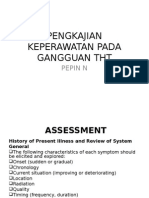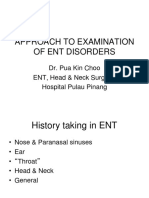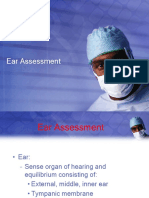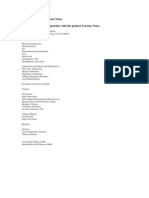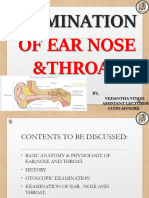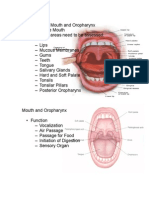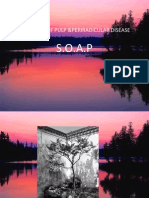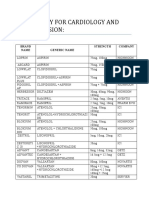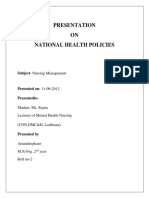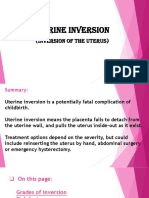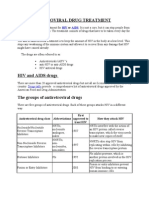Med 1 - 1st Shift - Lec - HEENT Neck Examination
Med 1 - 1st Shift - Lec - HEENT Neck Examination
Uploaded by
RJLeddaCopyright:
Available Formats
Med 1 - 1st Shift - Lec - HEENT Neck Examination
Med 1 - 1st Shift - Lec - HEENT Neck Examination
Uploaded by
RJLeddaOriginal Description:
Copyright
Available Formats
Share this document
Did you find this document useful?
Is this content inappropriate?
Copyright:
Available Formats
Med 1 - 1st Shift - Lec - HEENT Neck Examination
Med 1 - 1st Shift - Lec - HEENT Neck Examination
Uploaded by
RJLeddaCopyright:
Available Formats
Medi ci ne 1: HEENT/Neck Exami nati on Secti on 2A 2015
AY 2012-2013 Lecture 6
Outl i ne
Know what to ask
Know what to see
Knowledge of common ENT diseases
History of Present Illness
Location
Timing: onset, frequency, duration
Quality and/or Characteristics
Quantity and/or Severity
Setting and/or Situation
Aggravating and Alleviating Factors
Associated Factors
Underlying Concern
EENT EXAM
The ENT of head and neck is not fixed in
sequence
Different parts of the exam may be
excluded/included.
The ENT History
Briefer than the Internal Medicine history
(think surgical)
Key points (especially important in ENT):
o Smoking/alcohol history
o Numbers of infections (e.g. ear,
sinus, throat) in last 1, 2, 3
years
o Previous treatments
o Ears: hearing loss, pain, d/c,
tinnitus, vertigo
o Previous ENT surgeries
Ear - History
Otologic:
Hearing loss
o Onset and rate of progression
Otalgia
o Otologic vs. referred
Otorrhea
o Consistency?
Tinnitus
Vertigo
o Differentiate from !dizziness"
Noise exposure
Nasal
Obstruction, discharge etc.
Drugs
Ototoxic agents
Family History
Of hearing loss etc.
EAR EXAMI NATI ON
May be done while doing history taking.
Always examine both ears, not just the
affected ear.
Adults # pull ear backwards and upwards
Children # pull ear backwards and
downwards
Inspect auricles and mastoid region
o Size, shape, symmetry,
landmarks, color, position,
deformities or lesions
Palpate auricles and mastoid
o Tenderness, swelling, nodules
The Tympanic Membrane
Inspect external auditory canal (with
pneumatic otoscopy)
o Cerumen, color, lesions, d/c,
foreign bodies
Inspect tympanic membrane
o Landmarks
o Color, contour
o Perforations, mobility
o All 4 quadrants
Otitis Externa Normal Tympanic Membrane
Acute Otitis Media Tympanosclerosis
Perforation Cholesteatoma
Medi ci ne 1: HEENT/Neck Exami nati on Secti on 2A 2015
AY 2012-2013 Lecture 6
Ear # Hearing Assessment
Conducive Hearing Loss
o Disease affecting outer/middle
ear
Sensorineural Hearing Loss
o Disease affecting cochlea or CN
VIII
Mixed Hearing Loss
o Disease involving both middle and
inner ear
Response to questions during history
Response to a whispered voice
Tuning fork # air/bone conduction
o Rinne
o Weber
Interpretation of Tuning Fork Test
Test Expected
Fi ndi ngs
CHL SNHL
Weber No
lateralization
Lateralization
to ear with
loss
Lateralization
to better
hearing ear
Ri nne Air
conduction
better than
bone
conduction
Rinne (Rinne
positive)
Bone
conduction
better than
air
conduction
(Rinne
negative)
Air
Conduction
better than
bone
conduction
Nose and Paranasal Sinuses # History
Nasal
o Rhinorrhea
o Nasal obstruction
o Sneezing
o Discharge
o Olfaction
o Allergies
Sinuses
o Facial pain
o Dental pain
o Hearing loss
o Post-nasal drip
o Olfaction
o Congestion
o Discharge
NOSE AND PARANASAL SI NUSES EXAM
Inspect the external nose
o Share, size, color, nares
Palpate the ridge and soft tissues of the
nose
o Tenderness, displacement
cartilage/bone, masses
Evaluate patency of nares
Inspect nasal mucosa and septum
o Color, alignment, discharge,
swelling of turbinates, perforation
Inspect and palpate regions of the sinuses
Flexible/Rigid Endoscopy
Examples:
Sinusitis
Polyps
Septal perforation
Nasopharyngeal Carcinoma
Upper Aerodigestive Tract - History
Oral Cavity/Oropharynx:
o Pain
o Bleeding
o Dysarthria
o Numbness/Dysgeusia
o Referred otalgia
o Dry Mouth
Swallowing
o Dysphagia
! Solids vs. liquids
o Odynophagia
o Aspiration
o Reflux
Hypopharynx/Larynx:
o Dysphonia
o Dysphagia
o Cough/Hemoptysis
o Pain
o Shortness of breath
o Stridor
o Globus
Medi ci ne 1: HEENT/Neck Exami nati on Secti on 2A 2015
AY 2012-2013 Lecture 6
ORAL CAVI TY EXAMI NATI ON
Inspect lips and vermilion borders
o Symmetry, color, edema, surface
abnormalities
Inspect and palpate gingiva
o Color, lesions, tenderness
Inspect teeth
o Occlusion, caries, lose or missing
teeth
Inspect and palpate tongue and buccal
mucosa
o Color, symmetry, swelling,
ulcerations
Inspect palate, floor of mouth, uvula,
tonsils, oropharynx
NECK EXAMI NATI ON
Inspect the neck
o Symmetry, alignment of trachea,
fullness, masses, webbing, skin
folds, jugular vein distribution,
carotid artery prominence
Evaluate range of motion of neck
Palpate the neck
o Tracheal position, tracheal tug,
movement of hyoid bone and
cartilages with swallowing
Palpate the thyroid gland
o Size, shape, configuration,
consistency, tenderness, nodules
o Examine on deglutition
Lymph Node Groups
Palpate lymph nodes
o Size, consistency, tenderness,
warmth, mobility
Pre-auricular
Post-auricular
Occipital
Jugulodigastric
Submental/Submandibular
Facial
Anterior and Posterior Cervical
Supraclavicular
LARYNX EXAMI NATI ON
Indirect Laryngoscopy
o Hold patient$s tongue wrapped in
gauze with one hand
o Hold mirror in other hand against
soft palate
o Access vocal cord mobility,
lesions in region
Direct Laryngoscopy
o Posterior pharyngeal wall
o Posterior cricoid region, pyriform
recesses
o Vocal cord mobility and
appearance
o Arytenoid mucosa/cartilages,
aryepiglottic folds
o Epiglottis, valleculae, base of
tongue
Examples of Oral Cavity
Torus
Fibroma
Hemangioma
Papilloma
SCCA
Leukoplakia
Hypopharynx/Larynx # Fish bone
Vocal cord Papilloma
Vocal cord Nodule
Vocal Cord Polyp
Vocal Cord SCCA
You might also like
- BMJ's How To Read A Paper SeriesDocument1 pageBMJ's How To Read A Paper SeriesMuhammad Bilal SiddiquiNo ratings yet
- Mishin Gnerator With A Static Coil Manual: The Complete Set (Static Coil or Tesla) IncludesDocument11 pagesMishin Gnerator With A Static Coil Manual: The Complete Set (Static Coil or Tesla) IncludesJohnNo ratings yet
- Ent History Taking and Examination-1Document16 pagesEnt History Taking and Examination-1Jyotirmayee100% (6)
- DNB Obgy McqsDocument5 pagesDNB Obgy McqsSandip PatilNo ratings yet
- Handbook of Emergency Psychiatry 2007Document684 pagesHandbook of Emergency Psychiatry 2007Alicia Carrera Torres100% (6)
- Clerking and ReportingDocument24 pagesClerking and ReportingCarlous Shuga ChadwickNo ratings yet
- 1.md SchoolDocument30 pages1.md Schoolmesay zelekeNo ratings yet
- Pengkajian Keperawatan Pada Gangguan THTDocument35 pagesPengkajian Keperawatan Pada Gangguan THTSYAIFULNo ratings yet
- Approach To Examination of ENT DisordersDocument39 pagesApproach To Examination of ENT DisordersMohammad SaifullahNo ratings yet
- Ear, Nose and Throat AssessmentDocument4 pagesEar, Nose and Throat AssessmentLyka Milo AvilaNo ratings yet
- Otolaryngology For Medical StudentsDocument112 pagesOtolaryngology For Medical StudentsDrsreeram ValluriNo ratings yet
- Historytakingexaminationinent 141106091830 Conversion Gate01Document33 pagesHistorytakingexaminationinent 141106091830 Conversion Gate01sandeepNo ratings yet
- History and Examination in EntDocument71 pagesHistory and Examination in EntMuhammad Naquib AliNo ratings yet
- Assessment of Mouth & PharynxDocument79 pagesAssessment of Mouth & PharynxMUHAMMAD SALMANNo ratings yet
- 1.3 EarDocument28 pages1.3 EarStaphy AuNo ratings yet
- Clinical Discussion EarDocument90 pagesClinical Discussion EarMuhammad ZubairNo ratings yet
- Ear, Nose and Throat History and ExaminationDocument7 pagesEar, Nose and Throat History and ExaminationStetho Love100% (1)
- Ent (3) 11Document61 pagesEnt (3) 11kbrb2ksgdnNo ratings yet
- ENT Physical Examination (Head & Neck, Ear, Nose and Throat) Physical ExaminationDocument78 pagesENT Physical Examination (Head & Neck, Ear, Nose and Throat) Physical ExaminationMojahid AliNo ratings yet
- Pediatric: AssessmentDocument27 pagesPediatric: AssessmentJonathan PeterNo ratings yet
- THEEARDocument9 pagesTHEEARapi-3822433No ratings yet
- Pemeriksaan Fisik Kepala Dan LeherDocument39 pagesPemeriksaan Fisik Kepala Dan LeherdokteraanNo ratings yet
- Assessment of Deafness: Dr. Ajay Manickam JR - Dept of Ent RG Kar Medical CollegeDocument37 pagesAssessment of Deafness: Dr. Ajay Manickam JR - Dept of Ent RG Kar Medical CollegeDrravikumar BhandariNo ratings yet
- Introduction To Paediatric DentistryDocument48 pagesIntroduction To Paediatric DentistryReda Ismaeel100% (1)
- Ent ExaminationDocument85 pagesEnt ExaminationDevi Yusfita100% (1)
- Ear AssessmentDocument39 pagesEar AssessmentLyn MendeNo ratings yet
- ear ,nose and throat assessmentDocument63 pagesear ,nose and throat assessmentZohrahLiaqatNo ratings yet
- Unit IV Assesment Nose, Mouth & PharynxDocument30 pagesUnit IV Assesment Nose, Mouth & PharynxadnanhassanlhrNo ratings yet
- Ent Case 2Document29 pagesEnt Case 2Trina CardonaNo ratings yet
- Assessment of The Ear, Nose and ThroatDocument40 pagesAssessment of The Ear, Nose and Throatsnickers_j100% (3)
- EntDocument105 pagesEntNikhil KumarNo ratings yet
- Assessing Head, Face and NeckDocument112 pagesAssessing Head, Face and NeckHyacinth Jane Dela PeñaNo ratings yet
- Diseases of Oral Cavity FinalDocument117 pagesDiseases of Oral Cavity FinalRamanujam SridharNo ratings yet
- Otolaryngology PDA Toronto NotesDocument29 pagesOtolaryngology PDA Toronto NotesNor Aimi Abd Rahman100% (1)
- MouthDocument14 pagesMouthmalyn1218No ratings yet
- Clinical Examination of The Ear, Nose and Throat: Dave Pothier ST Mary's 2003Document30 pagesClinical Examination of The Ear, Nose and Throat: Dave Pothier ST Mary's 2003Ekambaram TrmNo ratings yet
- ENT EXAMINATIONGOOD-instrumentspdfDocument38 pagesENT EXAMINATIONGOOD-instrumentspdfNitin SharmaNo ratings yet
- Ent Case ProformaDocument26 pagesEnt Case Proforma5bz5vz7tgpNo ratings yet
- Examination of OropharynxDocument28 pagesExamination of OropharynxDr Sravya M VNo ratings yet
- Endodontic Diagnosis and Treatment PlanningDocument26 pagesEndodontic Diagnosis and Treatment PlanningHadil AltilbaniNo ratings yet
- Ent ExaminationDocument46 pagesEnt Examinationepic sound everNo ratings yet
- Physical Examination Head Neck Chest Breast and AbdomenDocument116 pagesPhysical Examination Head Neck Chest Breast and AbdomenSiva RamanNo ratings yet
- Oro-Antral CommunicationDocument65 pagesOro-Antral CommunicationNadila RNo ratings yet
- Paedodontics, 500 LEVEL FCDTT-1Document11 pagesPaedodontics, 500 LEVEL FCDTT-1Ude ChristopherNo ratings yet
- OHNS--Otolaryngology; Head and Neck surgery: pocket field guideFrom EverandOHNS--Otolaryngology; Head and Neck surgery: pocket field guideNo ratings yet
- 1 - Approach To The ENT PatientDocument20 pages1 - Approach To The ENT Patientali reza khatibiNo ratings yet
- Chapter 18 AnatomyDocument23 pagesChapter 18 AnatomyAltea PasiaNo ratings yet
- Assessing The Mouth and Oropharynx-WordDocument5 pagesAssessing The Mouth and Oropharynx-Wordmalyn1218100% (1)
- History Taking and Examination of EarDocument75 pagesHistory Taking and Examination of EarShisam PoudelNo ratings yet
- History Taking in Oral Cavity, Throat UgDocument48 pagesHistory Taking in Oral Cavity, Throat Ugmsashmita555No ratings yet
- Tongue Cancer FinalDocument37 pagesTongue Cancer FinalOktahermoniza TanjungNo ratings yet
- Diagnosis of Pulp and Periradicular Disease 2012Document75 pagesDiagnosis of Pulp and Periradicular Disease 2012keelerketo13No ratings yet
- Head & Neck AssessmentDocument45 pagesHead & Neck AssessmentSolomon Carla RectoNo ratings yet
- Patient Evaluation Diagnosis and Treatment Planning Inoperative DentistryDocument60 pagesPatient Evaluation Diagnosis and Treatment Planning Inoperative Dentistryawennadhim10No ratings yet
- Orientation and Introduction History & Physical Examination Dr. HasanDocument22 pagesOrientation and Introduction History & Physical Examination Dr. HasaniabudiehNo ratings yet
- Introduction HX and PEDocument22 pagesIntroduction HX and PEAhmed AyasrahNo ratings yet
- 1b. PENGKAJIAN PENDENGARANDocument35 pages1b. PENGKAJIAN PENDENGARANHanip Little-FaqotNo ratings yet
- 1. Ear Anatomy and PhysiologyDocument51 pages1. Ear Anatomy and PhysiologyGebita GemechuNo ratings yet
- ENT Case Proforma-EarDocument8 pagesENT Case Proforma-EarGaneshNo ratings yet
- Checklist EBP - Nose, Throat and MouthDocument6 pagesChecklist EBP - Nose, Throat and Mouths138140No ratings yet
- Clerkship - Lecture ENT SEM 7Document117 pagesClerkship - Lecture ENT SEM 7Goh Kah ManNo ratings yet
- Otitis Media With EffusionDocument28 pagesOtitis Media With Effusionpalwashaun66No ratings yet
- UROLITHIASISDocument7 pagesUROLITHIASISRJLeddaNo ratings yet
- Journal Report: Pgi Roben Ledda Jr. Pgi Ainee Krystelle LeeDocument18 pagesJournal Report: Pgi Roben Ledda Jr. Pgi Ainee Krystelle LeeRJLeddaNo ratings yet
- Klapp MethodDocument7 pagesKlapp MethodRJLeddaNo ratings yet
- Kinesio TapingDocument6 pagesKinesio TapingRJLeddaNo ratings yet
- Topnotch Microbiology Supertable - KindnesstoallDocument252 pagesTopnotch Microbiology Supertable - KindnesstoallRJLeddaNo ratings yet
- LEARNING ACTIVIdasdsaTY ON MOOD DISORDERDocument5 pagesLEARNING ACTIVIdasdsaTY ON MOOD DISORDERRJLeddaNo ratings yet
- Components of Emergency Medical SystemsDocument4 pagesComponents of Emergency Medical SystemsRJLeddaNo ratings yet
- Acr Practice Parameter For The Performance of Fluoroscopic Contrast Enema Examination in AdultsDocument8 pagesAcr Practice Parameter For The Performance of Fluoroscopic Contrast Enema Examination in AdultsHercules RianiNo ratings yet
- DNA VaccineDocument19 pagesDNA VaccineMahesh Yadav100% (1)
- Screenshot 2023-09-03 at 1.27.00 AMDocument8 pagesScreenshot 2023-09-03 at 1.27.00 AMhuzaifaawais27No ratings yet
- Formulary For Cardiology and Hypertension:: Brand Name Generic Name Strength CompanyDocument3 pagesFormulary For Cardiology and Hypertension:: Brand Name Generic Name Strength CompanyDr-Muhammad Junaid Hassan SharifNo ratings yet
- National Guideline For Patient Safety Incident Reporting and Learning in South Africa Version 2 - Web LayoutDocument82 pagesNational Guideline For Patient Safety Incident Reporting and Learning in South Africa Version 2 - Web LayoutSheena Mabaquiao-PadernalNo ratings yet
- Human Heart Human Heart: Biology Holiday's WorkDocument13 pagesHuman Heart Human Heart: Biology Holiday's WorkHimanshu GargNo ratings yet
- The Application of Cognitive Behaviour Therapy (CBT) For Depression: A Case Study of Iranian FemaleDocument8 pagesThe Application of Cognitive Behaviour Therapy (CBT) For Depression: A Case Study of Iranian FemaleHanilah RamliNo ratings yet
- Case Study Oriental MedicineDocument16 pagesCase Study Oriental MedicinepranajiNo ratings yet
- Updated List of Dentists As of September 2021Document4 pagesUpdated List of Dentists As of September 2021Xer Jr GnacagNo ratings yet
- National Health PoliciesDocument8 pagesNational Health Policiesajnesh100% (1)
- Uterine InversionDocument15 pagesUterine InversionMaggie Huatea Schnittka50% (2)
- Report-22 53Document14 pagesReport-22 53vaibhavnikhil06No ratings yet
- Chest Tubes Nursing CareDocument2 pagesChest Tubes Nursing CareYousef KhalifaNo ratings yet
- Procedure For Sterile Dressing Change and Wound IrrigationDocument6 pagesProcedure For Sterile Dressing Change and Wound Irrigationandeso everlineNo ratings yet
- Common ColdDocument39 pagesCommon Coldefatabilvian100% (1)
- Diagnostic Criteria Decision Tree PDFDocument2 pagesDiagnostic Criteria Decision Tree PDFNor Nadia ZakariaNo ratings yet
- Lect 4 BurnsDocument26 pagesLect 4 BurnsMawar BerduriNo ratings yet
- Ganoderma Ganotherapeiathefivestagesofaction - GanotherapyDocument4 pagesGanoderma Ganotherapeiathefivestagesofaction - GanotherapysakisgalanNo ratings yet
- Required Books For Pharm-D Edited (AutoRecovered)Document19 pagesRequired Books For Pharm-D Edited (AutoRecovered)Naveed AkhterNo ratings yet
- A Withinpatient Comparative Study of The Influence of Number and Distribution of Ball Attachment Retained Mandibular Overdenture 1011Document6 pagesA Withinpatient Comparative Study of The Influence of Number and Distribution of Ball Attachment Retained Mandibular Overdenture 1011dentureNo ratings yet
- Psycho Pathology of AnxietyDocument48 pagesPsycho Pathology of AnxietyTerry CampbellNo ratings yet
- Anti Diare SGDocument17 pagesAnti Diare SGludoy03No ratings yet
- Chlamydia Cass Z98226CE Rev11 en - de - NoDocument6 pagesChlamydia Cass Z98226CE Rev11 en - de - NoVentas2lp IcerlabNo ratings yet
- What Is HIV Antiretroviral Drug TreatmentDocument24 pagesWhat Is HIV Antiretroviral Drug TreatmentDhrishya PadmakumarNo ratings yet
- Drug Study 2Document4 pagesDrug Study 2roxybabesNo ratings yet
- Community Health Nursing PRETEST Day 1Document1 pageCommunity Health Nursing PRETEST Day 1Mcbry TiongNo ratings yet







